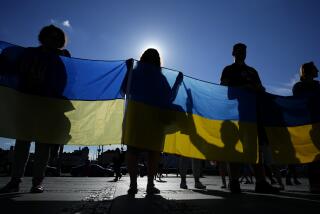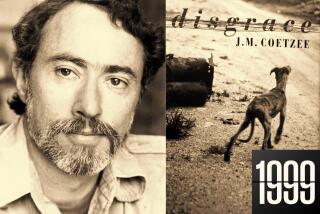THE FINAL CURTAIN : Global Fallout From Moscow’s Crash : No Tears Shed for the Mighty Kremlin’s Fall : REGIONAL PERSPECTIVE: EASTERN EUROPE
- Share via
WARSAW — There will be no rending of the garments, no tears shed in Eastern Europe as the Soviet Union officially passes out of existence.
In Poland, Czechoslovakia, Hungary, Bulgaria, Romania and what used to be East Germany, the satellite nations once lumped together as the Warsaw Pact--an alliance itself now on history’s trash heap--a population of 115 million will say goodby without an ounce of regret.
In this region, the power of the Soviet Union, wielded remorselessly after World War II, leaves behind it a collective memory of 45 miserable years--years of pain for a population whose living standards fell far behind those nations on the other side of the Iron Curtain and whose struggle to catch up will take the work of another generation.
It leaves behind political systems and parties wrestling with a dozen strains of nationalism and schemes for revenge, rapacious new capitalists snarling at social-welfare liberals and former Communist Party hacks growing prosperous on their old connections.
It leaves behind the physical stamp of the Soviet style--the dreadful “architecture” of postwar Stalinism--from such hideous extravaganzas as the Palace of Culture, towering into the murk above Warsaw, to the prefabricated gray high-rise worker hives that encircle any factory anywhere in the region, the begrimed slabs that house 60% of the population.
Whatever the later claims of “fraternal” relations, the legacy of Josef Stalin’s original intent for Eastern Europe remains evident. These countries, in his view, were to be industrial colonies--producing steel, coal, armaments, ships, glass, you name it, for Moscow. And all this is also left behind.
Drive through Silesia in Poland, northern Bohemia in Czechoslovakia, southeastern Germany, and the grand design of Soviet planners seems as permanent as the Tatra Mountains on the Czech-Polish border, where trees are dying in the sulfur. It is a wasteland. The river water here, on especially bad days, runs rich with carcinogenic chemicals. A square yard of Silesian soil contains, in some samples, enough lead to make a toy soldier. Levels of birth defects, mental retardation and lung disease are the highest in Europe, and life expectancy the lowest.
No one here questions why these depressing facts exist.
Grief for the demise of the Soviet Union?
Not likely.
Should anyone have forgotten it, perhaps in a mist of gratitude and sympathy for the now-superfluous Mikhail S. Gorbachev, the Soviet system imposed on this part of Europe was born in violence, deceit and tyranny. A decade ago, when Solidarity burst on the scene in Poland and loosened the system for a few months before the imposition of martial law, Teresa Toranska, a Polish journalist, conducted a remarkable series of interviews with the aging figures of the first Communist regimes in Poland, publishing the conversations in a book called “Them.”
One of “them” was Jakob Berman--for years after the war one of the most important figures in Poland and described by Toranska as the “brains” behind Poland’s Communist Party. Toranska asked him about the rigged postwar elections that brought the Communists to power.
Berman said the party’s actions were compelled by the situation. “In an election, we can’t go by the criterion of a majority, because then there isn’t anyone we can hand over power to,” he said flatly. “There wasn’t then and there isn’t now.”
By the same reasoning, evidently, Polish secret police in those early postwar years were executing 50 to 100 people a month. Up to 150,000 were held in security prisons and dungeons. This was the advent of communism in Eastern Europe, carried out with minor variations throughout the Soviet Bloc. Sham elections, always backed by force. It was never quite enough, of course, to tame the opposition. There were worker uprisings in Poland in 1956. Also in 1956, Hungary exploded with the first all-out armed insurrection against the Communists. It was put down mightily by the Soviet army, and the resulting round of purges, show trials, imprisonments and executions left Hungary stunned for a generation.
There was more Polish unrest in 1968, more shuffled governments, an anti-Semitic campaign launched by the party that would drive out most of the few thousand Jews still left in this charnel house of the Holocaust. And then, also in 1968, there was Czechoslovakia’s attempt to invent a “socialism with a human face,” a peaceful approach at reforming the Communist Party from within. And more Soviet tanks, more purges, more prison sentences.
If any country’s opposition carried the torch through those years between 1968 and 1989, it was Poland’s. There were worker uprisings in the shipyards of Gdansk in 1970, and another worker uprising in 1976 in Radom, where the Congress for Workers Rights was founded, a precursor to Solidarity, which exploded out of the shipyards in 1980. Solidarity became the most important opposition movement ever formed against the Communists. Born and put down by martial law during the deep-freeze years of Soviet leader Leonid I. Brezhnev, it would survive to triumph under the liberalizations of Gorbachev.
The Solidarity victory came, as a Communist’s sense of irony might have it, in an election--one carelessly programmed by the ruling forces in Warsaw in 1989. By a kind of oversight, the Communists actually allowed a group of 35 of their favored figures to be voted on, without opposition, by the public. Thirty-three went down to crushing defeat, precipitating the party’s gravest and final crisis.
One of the truly momentous events in Polish history, the vote inspired a sardonic summation from a local journalist--one that could stand as an epitaph for the era. “These people,” he said of the Communists, “have been rigging elections for so long, they think it happens automatically.”
That election was in June, 1989. By the end of December, there was not a Communist regime in the Warsaw Pact left standing.
A few days ago, the busy Russian President Boris N. Yeltsin, while forecasting an eventual Russian application for membership in the North Atlantic Treaty Organization, was telling journalists that much about the future in the former Soviet Union is simply “unpredictable.”
Certainly Eastern Europe would agree. Most of the countries in the former Comecon trading bloc were given a hard economic jolt early in 1991 when the Soviet Union simply stopped buying goods it had long been under contract to buy. Whole factories in Poland shut down. The arms industry in Czechoslovakia was in free fall. Factories that produced ball bearings or polyester pants, products once destined for freight cars headed northeast, sent large numbers of their workers home.
The fear now is not armed invasion but a drying up of business, for the Soviet Union has been a major trading partner--in fact, the largest for Poland, Czechoslovakia, Bulgaria and Romania. With the overarching union gone, business people here can hope that the new independent republics, individually or as a confederation, will eventually be customers again. Belarus, formerly called Byelorussia, is already buying large quantities of Polish potatoes.
Meanwhile, Eastern Europe has been looking to the West for the last two years. Poland, Hungary and Czechoslovakia hope to become full-fledged members of the European Community by the year 2000, with political integration coming--some optimists hope--in the next six years.
Overall, output in the former Soviet Bloc fell 2.2% in the last year, a recession (and consequent rise in unemployment) that could bear strongly on future growth. All of the former satellite countries are debating the speed and severity of economic reforms--how merciless should the newly embraced market system be in eliminating state-owned factories that lose money but employ thousands?
Polish politics is tangled in that question, sometimes to the point of near paralysis, as evidenced by the wariness of international lending agencies such as the International Monetary Fund and the World Bank. In 1991, 18% of Poland’s export income went to pay just the interest on its international debts. Without an agreement with the IMF, those terms could be even worse. If Poland’s designated prime minister makes good on his vow to slow down the country’s economic reform plans, the goodwill of Poland’s lenders could dry up quickly.
In a recent report, the Paris-based Organization for Economic Cooperation and Development said the output decline could turn around in Hungary by the middle of 1992. Czechoslovakia, it predicted, would lag behind somewhat, with Bulgaria and Romania still further behind.
Poland, it notes, has a chance of remaining at 1991 levels but could see a steeper decline in production if the country’s politicians succumb to pressure to water down the reform. Like a team of consulting physicians, the OECD economists are saying that the East European patients will improve, but only after enduring a course of nasty tasting medicine.
And what of East Germany? For years, it was argued that the East Germans were Eastern Europe’s best practitioners of communism--something about the fabled German discipline, as it was often said.
A visitor had only to look at the streets of an East German city to see the sham in the claim. Trash, filth, garbage, mess. Better than Poland, perhaps, or East Slovakia, but compared to West Germany (the East Germans were, after all, the same people, divided by the most artificial means) it was as though people from another planet lived on either side of the Wall. The difference was a system that had won no respect and inspired no sense of genuine civic duty. It had that look, common to all of Eastern Europe--neglected, run-down, seedy even where it was supposed to be grandiose.
And what did the “effective” Communists of East Germany leave behind? Rusted factories and poisoned rivers. Industry, with few exceptions, that is little more than scrap iron. More than $66 billion has already been spent to rebuild the dilapidated east, with much more to come.
Even for an economy that is the strongest in Europe, the reconstruction of the Communist mess has been a burden for Germany, bringing an upward surge in wages and prices, an inflation rate approaching 4%--a level the government says it cannot tolerate. The Bundesbank raised interest rates recently to a postwar German high in an effort to cool down inflation--a move that brought similar action from Belgium, the Netherlands, Denmark and Austria as well as pressure on others. The ripples spread, far beyond the site of the splash. The Wall falls in November, 1989, and the price of a home loan goes up in Antwerp in 1992.
Stalin has been credited with observing that communism fit Poland “like a saddle on a cow.” His method for ensuring the fit was simple. Hobble it, hold it down, cage it, pull the cinch as tight as it will go. His figure of speech was particularly apt for Poland, but close enough for the rest of communism’s subjects as well.
In the end, the problem for Eastern Europe, and for the Soviet Union, was that Stalin was right. It wasn’t that the cow couldn’t be hobbled, held or caged--perhaps for years longer than it was, perhaps even indefinitely. The problem was the saddle. It wouldn’t fit anywhere.
The saddle-makers won’t be missed.
More to Read
Sign up for Essential California
The most important California stories and recommendations in your inbox every morning.
You may occasionally receive promotional content from the Los Angeles Times.










